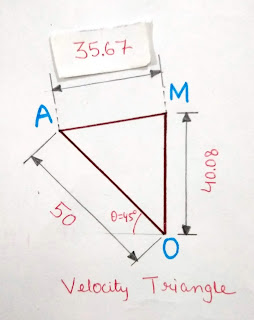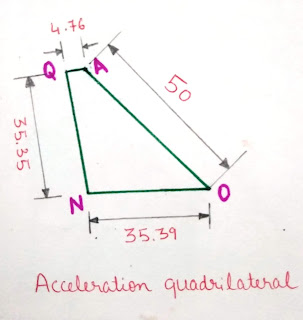Klein's Construction
Klein's Construction- is an graphical method to find velocity and acceleration of reciprocating parts of steam engine or internal combustion engine .
In Klein's Construction the velocity and acceleration diagrams are made on configuration diagram itself. The line that represents the crank in the configuration diagram also represents the velocity and acceleration of its moving end in the velocity and acceleration diagrams respectively.
By using this method we can find the velocity and acceleration of crank,connecting rod ,piston.
This method is applicable only if
The calculation part
In Klein's Construction the velocity and acceleration diagrams are made on configuration diagram itself. The line that represents the crank in the configuration diagram also represents the velocity and acceleration of its moving end in the velocity and acceleration diagrams respectively.
By using this method we can find the velocity and acceleration of crank,connecting rod ,piston.
Klein's Construction
This method is applicable only if
- α of crank=0 or
- ω of crank=constant
Method of obtaining velocity and acceleration
from the given values of crank length(r) and its angular velocity(ω) calculate crank velocity by
crank velocity Vc=r*ω
crank acceleration Ac=r*ω*ω
if dimensions of crank and connecting rod are such that they can be drawn on paper then there is no need to scale down the dimenions.
if dimensions of crank and connecting rod are relatively high then you need to scale down.
let us assume this as your configuration diagram.
where
IDC - Inner Dead Center
ODC - Outer Dead Center
Velocity Triangle
1. Extend the line PA of connecting rod backwards .
2. From center of crank draw an perpendicular upward to cut the extended line of connecting rod at M.
3. The meeting point of both the lines be M.
4. Triangle OAM is your velocity triangle.
Representations of various velocities
(OA)= velocity of crank which we have calculated very first
(AM)= velocity of connecting rod
(OM)= velocity of slider/piston.
Acceleration Diagram
1. Draw an circle1 taking A as center and AM as radius.
2. Locate the center of connecting rod ,let it be C .Through C draw an circle2 taking CA as radius.
3. These two circles will intersect at two points K and N .Through these two points draw a straight line that will cut the line of connecting rod at Q.
4. Join N with O.
5. Quadrilateral OAQN formed is your Acceleration Diagram.
(OA)= acceleration of crank which we have calculated very first.
(QA)= radial acceleration of connecting rod .
(QN)= tangential acceleration of connecting rod .
(ON)= acceleration of slider/piston.
let take a numerical to understand it better
Question 1. In a simple steam engine,the length of crank and connecting rod are 500 mm and 2670 mm . If the constant engine speed is 210 rpm and crank has rotated through 45 degrees from the Inner dead center. Determine
1. velocity of connecting rod.
2. velocity of piston.
3. angular velocity of connecting rod.
4. radial acceleration of connecting rod.
5. tangential acceleration of connecting rod.
6. acceleration of piston.
7. angular acceleration of connecting rod.
Ans.
as the given dimensions are quite large we need to scale it down.
let 500 mm=5 cm on paper
and 2670 mm= 26.7 cm on paper
N=210 rpm
N=210 rpm
ω=2πN/60
⇒ω=2*3.1428*210/60=22 m/s
This is the configuration diagram of given steam engine .
⇒ω=2*3.1428*210/60=22 m/s
This is the configuration diagram of given steam engine .
I have drawn the velocity triangle and acceleration quadrilateral separately for you to understand it.
In examinations there is no need to draw them separately. You can simply measure the dimensions and write them down .
You can have small variations in the dimensions below.
The calculation part
The answers are
velocity of connecting rod.=7.8474 m/s
velocity of connecting rod.=7.8474 m/s
velocity of piston.=8.8176 m/s
angular velocity of connecting rod.=2.939 rad/s
radial acceleration of connecting rod.=23.038 m/s៱2
tangential acceleration of connecting rod.=171.094 m/s៱2
acceleration of piston.=171.287 m/s៱2
angular acceleration of connecting rod.=64.080 rad/s៱2
In next blog i will explain you some more types of question on klein's construction.
If you have any doubt you can ask here.
If you have any doubt you can ask here.
Thanks for reading :)
Stay tuned...














Great work...
ReplyDelete